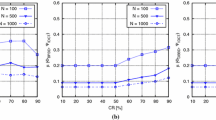Abstract
Performance of an ultra wideband (UWB) wireless system for real-time neural signal monitoring is evaluated by comparing spiking characteristics between transmitted and received signals for different experimental set-ups. Spike detection quality is selected as the main spiking characteristic of evaluated signals. Results are presented in receiver-operating characteristics and area-under-the-curve (AUC). In order to assess spike detection quality, a set of artificially generated neural signals is constructed from real neural recordings such that the ground truth is known. Data analysis shows how channel signal-to-noise-ratio (SNR) variation affects AUC in different signal SNR cases. Signals with low SNRs get less affected by reduced channel SNRs than those with higher SNR. Increasing bit error rate modifies spiking characteristics such that an under-estimation of the spiking frequency occurs due to spike losses. For practical application of real-time neural signal monitoring, UWB seems to offer best transmission conditions in a near-body environment.





Similar content being viewed by others
References
Anderson DJ, Oweiss KG (2003) Capturing signal activity and spatial distribution of neurons in a sub-millimeter volume. P Signal Syst Comput 1:387–390
Chen HY, Wu JS, Hyland B, Lu XD, Chen J (2008) A low noise remotely controllable wireless telemetry system for single-unit recording in rats navigating in a vertical maze. J Med Biol Eng Comput 46:833–839
Fernández E, Pelayo F, Romero S, Bongard M, Marin C, Alfaro A, Merabet L (2005) Development of a cortical visual neuroprosthesis for the blind: the relevance of neuroplasticity. J Neural Eng 2:R1–R12
Hochberg LR, Serruya MD, Friehs GM, Mukand JA, Saleh M, Caplan AH, Branner A, Chen D, Penn RD, Donoghue JP (2006) Neuronal ensemble control of prosthetic devices by a human with tetraplegia. Nature 442:164–171
Irazoqui-Pastor P, Mody I, Judy JW (2005) Recording brain activity wirelessly. IEEE Eng Med Biol 24:48–54
Kim S, McNames J (2007) Automatic spike detection based on adaptive template matching for extracellular neural recordings. Journal of Neuroscience Methods 165:165–174
Lebedev MA, Nicolelis MAL (2006) Brain-machine interfaces: past, present and future. Trends Neurosci 29:536–546
Mojarradi M, Binkley D, Blalock B, Anderson R, Ulshoefer N, Johnson T (2003) A miniaturized neuroprosthesis suitable for implantation into the brain. IEEE T Neur Sys Reh 11:38–42
Obeid I, Wolf PD (2004) Evaluation of spike-detection algorithms for a brain-machine interface application. IEEE T Bio-Med Eng 51:901–911
Oweiss KG (2005) Latency reduction during telemetry transmission in brain-machine interfaces. P IEEE Eng Med Biol Soc 2:2075–2078
Ryckaert J, Van der Plas G, De Heyn V, Desset C, Vanwijnsberghe G, Van Poucke B, Craninckx J (2007) A 0.65-to-1.4 nj/burst 3-to-10 ghz UWB digital tx in 90 nm CMOS. IEEE 802.15.4a. solid-state circuits conference, pp 120–591
Ryugo DK, Kretzmer EA, Niparko JK (2005) Restoration of auditory nerve synapses in cats by cochlear implants. Science 310:1490–1492
Tarin C, Traver L, Santamaria JF, Marti P, Cardona N (2007) Bluetooth-3g wireless transmission system for neural signal telemetry. P IEEE Wirel Telecommun Symp 29:120–591
Yu SN, Cheng JC (2006) A wireless physiological signal monitoring system with integrated bluetooth and wifi technologies. Conf Proc IEEE Eng Med Biol Soc 3:2203–2206
Author information
Authors and Affiliations
Corresponding author
Rights and permissions
About this article
Cite this article
Tarín, C., Traver, L., Martí, P. et al. Ultra wideband for wireless real-time monitoring of neural signals. Med Biol Eng Comput 47, 649–654 (2009). https://doi.org/10.1007/s11517-009-0480-x
Received:
Accepted:
Published:
Issue Date:
DOI: https://doi.org/10.1007/s11517-009-0480-x




